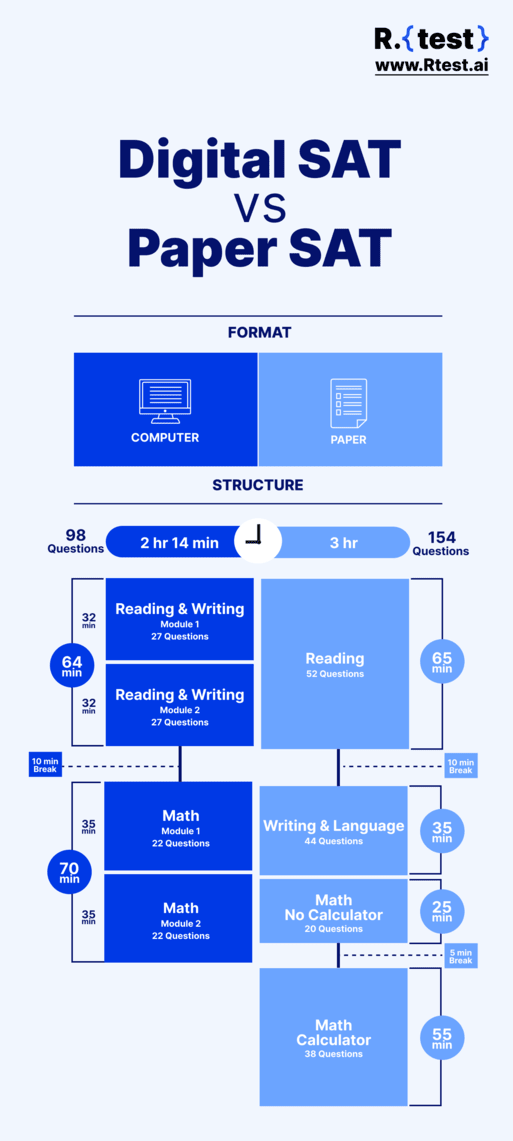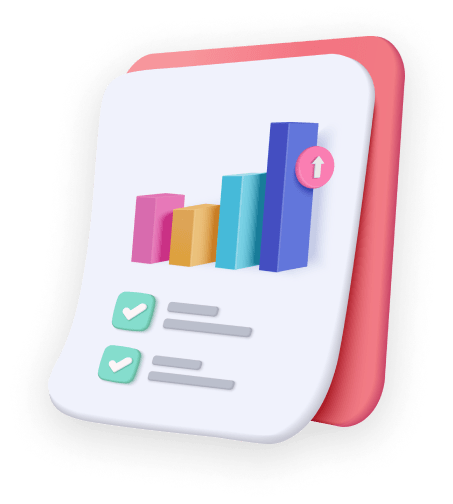What is the Digital SAT and What are the Changes?
The SAT exam is undergoing a major revamp: discover the latest updates and improvements implemented after the digital transformation of the Digital SAT.
The SAT Enters the Modern Era!

The SAT is a nearly hundred-year-old exam given to prospective college students. As it nears its hundredth birthday in 2026, the College Board is giving it a major revamp. The format for the exam is changing from the traditional pencil and paper exam to a brand new digital format. This change will go into effect in 2023 for international students and 2024 for U.S. test takers. In this post, we will cover the major changes from the current SAT to the digital SAT.
What’s changing from paper SAT to digital SAT?

Testing Format
One big change that is happening with this new digital exam is the way the exam is being given - it's going from paper-based testing (PBT) to computerized adaptive testing (CAT). Basically, the exam will be given on a computer, either on a device provided by your school or your own device. If you don't have a device, you can borrow one from the College Board when you register for the exam.
To make sure the exam is fair and accurate, it will be given through a special SAT app, called Bluebook, that is designed just for this purpose. This will also help prevent cheating and give everyone an equal chance to do their best.
Stage Adaptive
With the new computer-adaptive test (CAT) system, the exam is now designed to adapt to a student’s individual needs. Here's how it works: the test is divided into two parts, or modules. In the first module, you'll answer questions of different levels of difficulty, from easy to hard. Based on how you perform in this stage, the test will adjust the difficulty of the questions in the second module. This means that you'll be presented with questions that match your abilities.
The second module is split into two difficulty levels: higher difficulty and lower difficulty. The higher difficulty module will be given to students who answer more questions correctly in the first section, and the lower difficulty will be given to students who answer fewer questions correctly in the first section. This means that the set of questions you will receive in the second module will depend on the result of the first module.

Start preparing for theDigital SAT today
Take a 15 minute test and get yourAnalytics Report!
Scoring
With the new digital exam, students who take the higher difficulty module in the second stage will be able to achieve the top score. However, there is a change in scoring for those who get fewer questions correct in the first section. If you are presented with the lower difficulty module and score 100% on that section, you won’t be able to reach the perfect score that those who take the higher difficulty module can achieve. This is because the final score ranges for the two different difficulty modules in the second stage differ.
Here's a tip: take your time on the first module, as it can increase your chances of reaching the higher score range.
Time Updates
One good thing about the new digital exam is that it's shorter. The old paper-based SAT used to take 3 hours, but now the new digital version only takes 2 hours and 14 minutes. Even though the total amount time has shortened, you'll actually have more time to answer each question compared to the old test.
Security
According to the College Board, the new digital format can help prevent cheating and other issues that could make scores invalid. During the old paper-based tests, one act of cheating by a single student could make all of the scores invalid, which meant everyone had to take the test again. With the new CAT format, almost every student gets a different set of questions, which makes it much harder for students to cheat by sharing answers.
Is the digital SAT harder than the paper SAT?
No, not really. The College Board hasn't changed the level of difficulty or expectations for students. They just made the digital format more user-friendly and accessible for students and teachers. So, both exams have the same level of challenging content and difficulty. However, there are some changes being made to each section of the SAT, so you might want to keep an eye on that as well.
What does this mean for you?

The new updates to the SAT exam are designed to help you as a student. With the new computerized testing, the exam can accurately and quickly assess your strengths and weaknesses. As the second module adjusts based on your abilities, this new system will provide you with a better assessment of your mastery of the content.
The digital format of the exam is also beneficial to students as it streamlines the materials and is more in line with the technology we use every day. Plus, the grading is done by a system which ensures higher quality control with grading and results.
What’s next?
The new digital SAT is a sign of the times as more and more things move online. It also aims to break down barriers that have prevented some students from succeeding on the test. While there's no direct comparison between the digital and paper-based tests, you should still strive to do your best on both. If you want tips on how to prepare for the digital SAT, check out our post on Digital SAT Preparation with R.test.
Remember, the SAT is just one part of your college application, and there are many resources available to help you prepare. By understanding what the digital SAT is and how it works, you can feel more confident and ready to take it on. You've got this!
Let R. test set a smart path for you! Discover your strengths and weaknesses with R. test Let R. test set a smart path for you! Discover your strengths and weaknesses with R. test